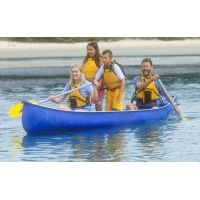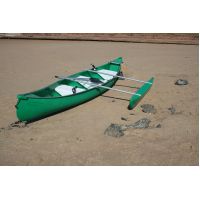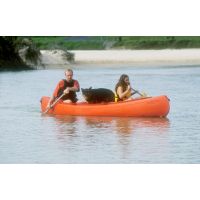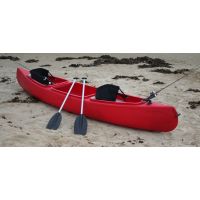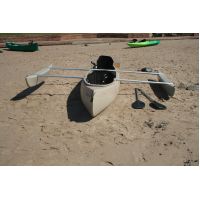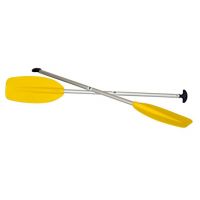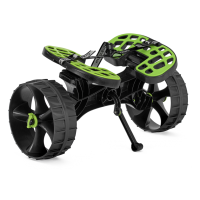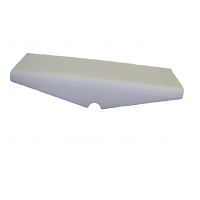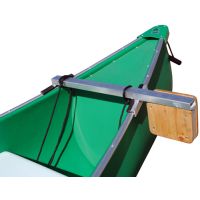Cart is empty
Hull Shape
There are many features and options that the designer can choose to include or omit with the overall decision being dependent on the end benefit or performance that he/she would like the boat to have or do.
The different features to consider when looking to purchase a canoe, kayak, sea kayak or sit-on-top can be found under each heading.
- Hull Shape - see below
- Seats
- Steering Systems
- Rudders
- Hatches
Note:
There are numerous technical terms used in this section, so for your convenience, we have included definitions at the bottom of the page.
FEATURES EXPLAINED - HULL SHAPE
There are many, many different shapes that a kayak hull can be, and all offer the paddler different benefits.
The factors that you need to consider when choosing the type of hull that your kayak will need to have will depend on:
- Speed - how fast do you want to be able to go?
- Stability - how stable do you want your kayak to be?
- Tracking ability - how easy do you want it to be to keep your kayak in a straight line?
- Turning ability - how easy do you want it to be to turn your kayak?
Note:
You will usually need to "trade-off" one feature against another.
The first "trade-off" is speed or stability.
- A longer kayak will be faster, but is generally narrower, and will therefore be less stable than a shorter, wider (slower and more stable) kayak.
The second "trade-off" is tracking for turning
- A kayak that is easier to keep in a straight line, will be harder to turn, and a kayak that is easier to turn is generally harder to keep in a straight line.
Whilst the above is correct in general terms, there are then additional features that can be incorporated into the shape of the hull that will reduce or amplify the performance that you will get out of your kayak.
The features that we will discuss in this section will include:
- Hull shape
- Rocker
- Bow Shape
HULL SHAPE
Whilst there are a number of options with regard to hull shape that a designer can choose from, generally they will choose one of the following options:
- Multiple chines
- Flat
- Round
Hull - Multiple Chines
At Australis, we use a "multi-chined" hull because:
- it has primary and secondary stability;
- it holds its shape better in plastic because the shape naturally pushes out on itself;
- is a more advanced shape for: ◦speed
- turning: ◦rough conditions (especially in open ocean paddling)
When you paddle a sea kayak, you need to lean it to turn, so that it gives you a "short" edge and a "long" edge. This means that the kayak will pivot and turn fast.
A multi-chined hull allows you to easily lay the kayak over, whilst still maintaining exceptional stability, and gives you a definite short and long edge for superior turning.
Hull - Flat
Whilst a "flat" hull is ok on flat water, at Australis we don't use this style on our sea kayaks and touring kayaks because:
- Whilst the "primary" stability is quite good, it does not have usable "secondary" stability.
The secondary stability is the sides of the boat from the bottom to the top, and whilst it is harder to lean a flat bottomed hull over to this edge than it is with a multi-chined hull, once you are to that point, it is harder to bring the kayak back to the primary stability meaning that it is easier to capsize. This makes a flat hull unsuitable to use in waves or rough conditions;
- A sea kayak will a "flat" hull will usually get "oil canning". This is where there is "dishing" into the shape of the boat because there is no support to hold the shape.
The designer can try to overcome this problem by moulding "channels" into the bottom to try and keep the shape, but you actually need to hold the shape out, not in, and channels can catch on rocks.
Hull - Round
Whilst a "round" hull is also ok on flat water, it is even less stable than a flat hull because there are no definite edges, and as you lean the kayak, you will not feel any warnings before the kayak tips over if you lean too far.
Round hulls do hold their shape fairly well and do not tend to "oil-can", but at Australis we don't use this style on our sea kayaks and touring kayaks because of the inferior secondary stability.
ROCKER
Rocker is the line of curve that you will see from the front to the back of the kayak when you look at it from the side profile view.
Rocker is included in a kayak to assist with:
- turning;
- a smoother ride.
Turning
Rocker helps with turning because it allows you to move your centre of gravity towards the back of the kayak by leaning your upper body. This lifts the front of the kayak out of the water, and when you put your paddle into the water to act as a pivot point, there is less kayak in the water at the front and the kayak just naturally turns.
Smoother Ride
Rocker gives a smoother ride because it allows the kayak to naturally tilt back when you are paddling along in conditions that include waves.
A kayak with little or no rocker will tend to go straight over the wave until the weight at the front on the kayak is heavier than the weight at the back, and the kayak then "slaps" down on the other side of the wave.
A kayak with rocker at the back will tilt back and then as it comes back down on the other side of the wave, the rocker in the front will cushion the bow coming back down making for a more enjoyable paddling experience.
Note:
Whilst Rocker makes it easier to turn a kayak, it can make it more difficult to keep the kayak on a straight course.
By including a keel in a boat with rocker, you will get a kayak that will turn well and run easily in a straight line.
(You can see this in the excellent surfing ability of our Squid and Ocky sit-on-tops).
BOW
The shape of the bow will determine whether the boat will be a "wet" or a "dry" boat to paddle.
A "wet" boat is one that will throw water straight up, and as you paddle forward, you will paddle into the spray and get wet.
A "dry" boat is one that will throw the water up and away from the midline of the hull, so that when you paddle forward, you are paddling into air and not water.
The bow on Australis Saratoga and Lizard Sea Kayaks "rakes back" at a gentle angle to give a smooth lift over waves and because there is not a severe angle, they do not "push" water like some boats can.
Also, the combination of the "raked back" bow and rocker in the Australis kayaks, means that they will lift in rough conditions rather than "bury".
CONCLUSIONS
The hull shapes that we use at Australis are more advanced than most of our competitors.
We make "expert" boats that beginners can use and "grow into" as skill levels improve, but that experts can use for all of their required moves.
A lot of competitive products are easy for novice paddlers to use, but experts will find that they are frustrating because they are too basic.
Also, you will find that continually having to upgrade your kayak will end up costing you more time and money in the long run, than choosing a kayak that you initially find a bit challenging but that you are able to use.
DEFINITIONS:
Primary Stability is provided by the very bottom of your kayak, and the flatter the bottom, the more stable that the kayak will feel because there is more surface area of the kayak sitting directly onto the water.
When you try sitting in kayaks with different shaped hulls, you will notice that some will have a little more movement than others, and some will have less.
A kayak with multiple chines tends to feel a little less stable, but actually has more stability when you include...
Secondary Stability.
A kayak with secondary stability is like a bike with training wheels in that you can lean the kayak over onto the edge and you will feel a definite "catch-point".
Whilst secondary stability does offer you some security of knowing when you are reaching your "safety zone" for tipping out, it will not prevent you from falling out and if you continue to lean, the kayak will probably capsize.
Secondary stability is most commonly experienced with "multi-chined" hulls.
© 2013-2025 Australis Canoes. Powered by AVS Online Store

